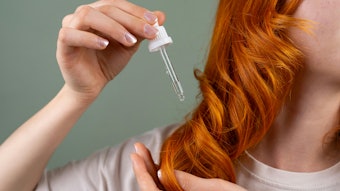- Although sticks are the most popular form of APs, they are not necessarily the ideal form to deliver the highest level of efficacy.
- The ingredients necessary to produce a consumer-acceptable AP solid with optimized performance can be divided into four categories.
- Although limited AP innovation currently is taking place, there is room for it in the market, especially in relation to consumer-perceivable improvements.
- The primary focus of AP products had been on minimizing wetness. More recently, the trend has been to focus first on odor protection and then on wetness protection.
Deodorants have been used for more than 5,000 years, with many major civilizations having left a record of efforts to mask body odors. The early Egyptians, for example, recommended application of perfumed oils such as citrus and cinnamon preparations. Applications have evolved from masking offensive odors with simple perfumed oil to today’s complex deodorant and antiperspirant (AP) applications.
APs have been around for more than 100 years. The first commercial deodorant, Mum, was patented in 1888 by an unknown inventor, and the first antiperspirant with aluminum chloride, Ever-Dry, was produced 15 years later.1 Since that time, APs have morphed in the complexity of their delivery systems and associated actives—from simple pads and squeeze bottles with astringent acidic compounds to more sophisticated sticks and soft solids that use a buffered active.
Each AP form and active change has been initiated either by: 1) a technological breakthrough—e.g., roll-ons evolving from the invention of the ballpoint pen, or polymeric hydrated aluminum oxides evolving from the molecular manipulation of simple aluminum chloride; 2) regulatory requirements such as the development of solid sticks resulting from a ban on fluorocarbon propellants; or 3) a marketing claim for the novel use of a technology or a unique delivery system—the “clinical strength” claim, for example, originating from the advent of drug labeling requirements.
Although sticks are the most popular form of APs, they are not necessarily the ideal form to deliver the highest level of efficacy. This is due to the fact that water-soluble AP actives must transport through a waxy matrix, slowing the process of delivery. Extrudable, opaque, creamy soft solids deliver higher levels of efficacy because their lower amounts of waxy ingredients improve the availability of the active to the sweat glands. Extrudable, clear gel solids deliver lower efficacy because some of the ingredients therein are believed to inhibit the availability of actives to the sweat glands. Therefore, to best optimize the performance of AP sticks, one must understand the production process and the ingredients best suited for them.
The Ingredients
The ingredients necessary to produce a consumer-acceptable AP solid with optimized performance can be divided into four categories, the first of which includes actives that block sweat expulsion by forming temporary plugs within sweat ducts, thus stopping or slowing the flow of sweat to the surface of the sweat glands.2 Plugging the sweat glands causes an osmotic pressure and prohibits transportation of sweat to the skin surface. If application of an active ceases, plugs eventually are pushed from the glands, allowing normal sweat release to resume.
Stick and soft solid systems require a powdered active, and particle sizes can vary from macro-sized (up to 75 microns) to micro-sized (below 10 microns). If the particle size is too large, consumers will detect its presence when rubbing the hard particle in the underarm area. Ideally, an active with a particle size below 45 microns ensures a non-perceptible skin feel. In gels, the concentration of the active solution is important, and, ideally, a high concentration active solution (45–50%) is recommended.
The second category of ingredients to produce consumer-accepted, efficacious APs includes carrier systems. AP solids must incorporate carrier systems that work synergistically with a product’s solidification system. In addition, the carrier systems should at least partially evaporate so as not to leave white residue or a hydrophobic film on the skin, which can inhibit the active’s transport. Historically, carrier systems for AP solids have widely been based on ingredients that evaporate quickly and do not leave residue on the skin.
Solidification systems are the third category of ingredients of interest in the formulation of AP products. These systems are critical to developing solid sticks that do not melt under typical storage or consumer conditions, but provide an elegant skin feel and allow for easy transfer of formula to armpits. The dynamics between solidification and volatile carrier ingredients have been investigated3, 4 and reveal that the stability and aesthetics of AP sticks are critically related to the ratio of ingredient in products and the way in which the formulas are processed. Today, most solid sticks represent a combination of cyclopentasiloxane and stearyl alcohol with varying degrees of additional waxes.
In the case of extrudable soft solids, higher amounts of cyclopentasiloxane and lower levels of waxes typically are used and the pour temperature is not a critical consideration. However, the pour temperature does need to be controlled to avoid the settling of suspended AP actives before a formulation is set.
The fourth category of AP ingredients is comprised of miscellaneous additives—which represent a catch basin for functionally optional ingredients. Examples include: talc, cornstarch, silica, fragrances, antioxidants, chelating agents, colorants, botanicals (that are usually tied to a specific claim) and odor-controlling agents.
Trends in APs
Although limited AP innovation currently is taking place, there is room for it in the market, especially in relation to consumer-perceivable improvements. Consumers seek brands that offer extended protection against body odor and perspiration. Therefore, the AP industry is formulating products with “long-lasting” claims that involve the duration of the fragrance. With the emergence of niche markets, AP marketers have begun to target niche-market consumers globally—with, for example, organic lines in Europe, non-whitening formulas in Asia, eco-friendly lines in Latin America and clinical strength/prescription-like over-the-counter products. For years, the primary focus of AP products has been on minimizing wetness, with the secondary focus being on odor protection. More recently, the trend has been to focus first on odor protection and then on wetness protection. One possible reasons for this change are efforts by marketing to meet consumer demand for differentiation in the available product offerings and the successful consumer response to “deo-cologne” deodorant sprays.
Finally, with the natural movement, APs are going green. Since the AP product category is regulated in the U.S. and other countries as a drug, there is limited opportunity to develop natural AP actives. Therefore, the “natural” push has primarily focused on deodorant claims.
References
- K Laden and C Felger, “Antiperspirant and Deodorants,” vol 7 in Cosmetic Science and Technology, Marcel Dekker Inc.: New York (1988) pp 3–5
- K Laden, Antiperspirant and Deodorants, 2nd ed, Marcel Dekker Inc.: New York (1999)
- RJ Scott and ME Turney, Volatile Silicones in Suspensoid AP Sticks, J Soc Cosmet Chem, 30(3/4), 137–156 (1979)
- IB Chang and RA Smith, AP Sticks, Cosmet Toil, 104, 115–124 (1989)
Eric Abrutyn is an active member of the Society of Cosmetic Chemists, an advisory board member for C&T magazine, and chairman of the Personal Care Products Council’s International Nomenclature (INCI) Committee. Recently retired from Kao Brands, Abrutyn founded TPC2 Advisors Ltd., Inc., a personal care consulting business. Abrutyn has more than 35 years of experience in the raw material supplier and skin and hair care manufacturer aspects of personal care.


!['Snoopy and Woodstock are cherished [characters] across generations and pairing them with our most-loved body care essentials creates a collection that feels classic with a modern twist. This launch is about celebrating our community with something unforgettable while starting an exciting new era for the brand,' said Luis Garcia, Chief Marketing Officer.](https://img.gcimagazine.com/mindful/allured/workspaces/default/uploads/2025/10/tree-hut-peanuts-fullcollection-fall26-1x1-1253.lGcuurUszp.jpg?auto=format%2Ccompress&fit=crop&h=191&q=70&w=340)







